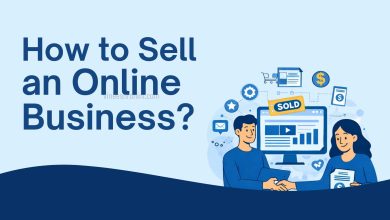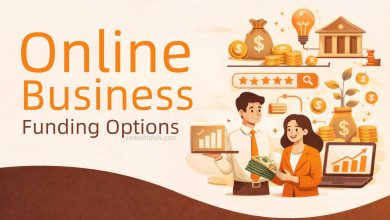How to Start a B2B Online Business ? : Comprehensive Guide 2025
How to Start a B2B Online Business : The digital age has transformed how businesses operate, collaborate, and transact. With the B2B (Business-to-Business) landscape evolving rapidly due to e-commerce platforms, automation tools, and cloud-based infrastructure, entrepreneurs in 2025 are increasingly shifting focus toward B2B online business models. A B2B online business involves providing products or services to other businesses through digital platforms, streamlining processes, reducing costs, and unlocking global opportunities.
Table of Contents
From SaaS platforms and B2B marketplaces to digital product providers and consultancy services, B2B e-commerce is projected to surpass $25 trillion globally by 2028. Whether you’re an aspiring founder, freelancer, or small business owner, building a B2B online business in 2025 can lead to sustainable revenue, long-term contracts, and strong business relationships.
This comprehensive guide explains what B2B online business is, its types, how to build and scale it step-by-step, the tools required, marketing strategies, challenges, and future trends. By the end of this essay, you’ll have a complete roadmap to start your B2B online venture with confidence.
What is a B2B Online Business?

A B2B online business involves selling products, services, or solutions from one business to another using digital platforms.
Also Read : Affiliate Links are Not Converting, Why ?
Unlike B2C (Business-to-Consumer), where companies sell directly to end-users, B2B focuses on solving business problems, improving operations, and enabling growth for other companies.
Examples of B2B Online Businesses in 2025:
- SaaS Tools (e.g., CRM, accounting, HR management)
- Digital Marketing Agencies (SEO, PPC, email marketing for businesses)
- B2B Marketplaces (like Alibaba, IndiaMART)
- Online Wholesalers (bulk orders of goods to retailers)
- Enterprise Software Resellers
- Cloud Hosting and Infrastructure Providers
- B2B E-commerce Platforms (like Shopify B2B, Magento Commerce)
Why Start a B2B Online Business in 2025?
1. Recurring Revenue Potential
B2B models often involve long-term contracts or subscription-based services, offering financial stability.
2. Higher Order Values
Businesses are willing to pay premium rates for reliable tools and services that improve efficiency and ROI.
3. Lower Customer Churn
B2B relationships take time to build, but once established, clients tend to stick with vendors due to integration and trust.
4. Remote Operation Possible
Most B2B online models can be built, scaled, and managed 100% remotely, making it ideal for solopreneurs and digital founders.
5. Growing Global Market
With digital transformation being a key focus in 2025, even traditional businesses are looking for B2B digital solutions.
Types of B2B Online Business Models
1. Product-Based B2B
- Selling physical goods to retailers, wholesalers, or resellers via online platforms.
- Example: Selling packaging materials to e-commerce brands.
2. Service-Based B2B
- Offering digital or consulting services to businesses.
- Example: Providing content writing, accounting, or legal consulting services.
3. SaaS (Software as a Service)
- Providing businesses with access to cloud-based tools.
- Example: HR management, marketing automation, project tracking tools.
4. Marketplace Model
- Connecting sellers and buyers within a niche.
- Example: A platform connecting manufacturers with retailers.
5. Information Products
- Selling templates, frameworks, e-books, or course bundles to startups and SMBs.
Step-by-Step Guide to Starting a B2B Online Business in 2025
Step 1: Identify a Profitable Niche
Success starts with finding a problem worth solving. Use the following methods:
- Research underserved industries (e.g., logistics, local manufacturers, educational institutes)
- Join communities (Reddit, LinkedIn, Slack) to discover common business pain points
- Explore freelance platforms (Fiverr, Upwork) for recurring business tasks
Examples of profitable niches:
- Supply chain automation for small exporters
- Local SEO for restaurants and clinics
- Payroll processing for SMEs
- Data analytics for e-commerce sellers
Step 2: Validate Your Idea
Before building anything, validate demand:
- Run surveys or interviews with target businesses
- Launch a simple landing page with a waitlist form
- Offer a basic prototype or MVP for early feedback
- Use cold email or LinkedIn outreach to test interest
Step 3: Define Your Business Model and Pricing
Choose how you’ll monetize:
- Subscription (monthly/annual)
- One-time service fee
- Usage-based billing
- Retainer contracts (for consulting or recurring services)
- Commission (for marketplaces)
Set pricing based on:
- Value delivered (ROI)
- Industry benchmarks
- Operating costs and desired profit margin
Step 4: Build a Professional Online Presence
You need a clean, conversion-optimized digital storefront:
- Website: Use platforms like Webflow, WordPress, or Shopify (for B2B e-commerce)
- Logo & Branding: Establish credibility with a cohesive visual identity
- Domain & Email: Use a custom business email like yourname @ yourcompany . com
- Landing Pages: Create separate pages for each solution/offering
Step 5: Develop the Core Offering
If you’re a SaaS:
- Use tools like Bubble (no-code) or custom development with React + Firebase
If you’re a service provider: - Create clear service packages with defined deliverables and timelines
If you’re selling physical goods: - Build a B2B-friendly catalog with quantity-based pricing and GST-inclusive invoices
Step 6: Set Up Payments and Invoicing

B2B customers expect GST-compliant invoices, bank transfers, or PO-based payments.
Use:
- Stripe (global clients)
- Razorpay or Instamojo (India)
- Zoho Books or QuickBooks for invoicing
Also, set clear policies on:
- Refunds
- Delivery timelines
- Contract renewals
Step 7: Create Lead Generation & Sales Funnel
Use a combination of inbound and outbound marketing:
Inbound:
- Blog content optimized for B2B keywords (e.g., “best CRM for real estate firms”)
- Case studies, white papers, and testimonials
- Lead magnets (free guides, checklists)
Outbound:
- Cold emails to decision-makers
- LinkedIn connection + value message strategy
- Email sequences via tools like Lemlist or Instantly.ai
CRM Tools:
- HubSpot
- Pipedrive
- Zoho CRM
Step 8: Build Trust and Close Sales
- Use consultative selling: understand pain points before pitching
- Offer free trials or pilot projects
- Create pitch decks or demo videos
- Handle objections by showcasing ROI and results
Step 9: Deliver Outstanding Service
- Communicate timelines clearly
- Use tools like Slack, Trello, or ClickUp for collaboration
- Offer dedicated support
- Collect feedback and implement improvements
Step 10: Retain Clients and Scale
- Introduce loyalty discounts or upgraded packages
- Upsell new features/services
- Request referrals and offer affiliate incentives
- Automate onboarding, reporting, and feedback loops
Must-Have Tools for B2B Online Business in 2025
Website & Funnel Building:
- Webflow, Leadpages, Unbounce
CRM & Email:
- Zoho CRM, HubSpot, Mailmodo
Accounting & Payments:
- Razorpay, Zoho Books, Stripe
Collaboration:
- ClickUp, Slack, Loom
Marketing:
- SEMrush, Surfer SEO, Buffer, Canva
Lead Gen & Outreach:
- Instantly.ai, Apollo.io, Hunter.io
B2B Digital Marketing Strategies That Work in 2025
1. LinkedIn Marketing
- Post case studies, infographics, and founder stories
- Run targeted ads based on job titles, company size, and industry
- Join LinkedIn groups to connect with leads organically
2. SEO & Blogging
- Create blog posts targeting intent-driven keywords (e.g., “HR software for startups”)
- Use on-page SEO, schema markup, and internal linking
- Update content regularly with new insights
3. G Ads for B2B
- Target with exact-match keywords and narrow geographies
- Offer white papers or calculators as landing page incentives
4. Webinars & Events
- Host monthly webinars with experts or clients
- Collect leads during registration
5. Video Content
- Explainers, behind-the-scenes, client stories
- Post on YouTube, LinkedIn, and your website
6. Account-Based Marketing (ABM)
- Identify top 100 potential clients and craft personalized campaigns
Common Challenges in B2B Online Business
- Slow Sales Cycle: B2B decisions take longer due to multiple stakeholders
- Trust Factor: Businesses are cautious with vendors—build credibility
- Technical Integration: Some businesses require complex onboarding
- Price Sensitivity: Especially for startups and SMEs, pricing matters
- Customer Retention: B2B clients demand ongoing value and support
Pro Tip: Offer onboarding, documentation, and dedicated support to reduce churn.
Trends Shaping B2B Online Business in 2025
- AI and Automation
Tools like ChatGPT, Jasper, and Zapier streamline customer service, marketing, and lead qualification. - No-Code Movement
Non-tech founders are building and scaling B2B platforms using no-code tools. - Personalized Buyer Journeys
Businesses expect tailored recommendations, smart follow-ups, and dynamic pricing. - Mobile-Optimized B2B Platforms
With decision-makers using mobile, B2B interfaces are now mobile-first. - Sustainability & Compliance
ESG (Environmental, Social, Governance) and data privacy are major priorities for B2B buyers.
How to Start a B2B Online Business – Conclusion

Starting a B2B online business in 2025 offers immense opportunity. With lower barriers to entry, advanced tools, and a digitally savvy business ecosystem, entrepreneurs can build scalable, high-margin, and long-term ventures. Whether you’re offering a SaaS tool, marketing service, or product marketplace, focus on solving real problems for businesses.
Buy Now : Ecommerce Website
Validate your idea, build a minimum viable product or service, create a strong brand presence, and use effective marketing to reach decision-makers. Keep refining your offer based on feedback, prioritize client success, and use automation to scale efficiently.
Disclaimer : This content is for informational purposes only. It is not legal, financial, or business advice. Please consult professionals before making business decisions.



